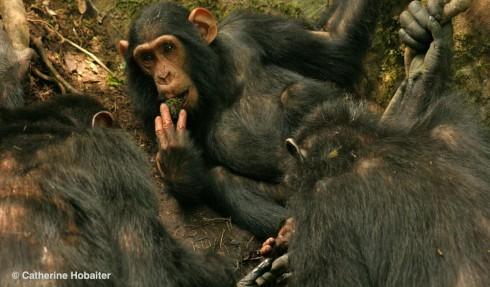Chimps can learn behavior from one another, a new study shows
A young female chimpanzee called Karibu learned to use a moss sponge after observing her mother, Kwera, using the new technique.
A new study documents for the first time that chimps in the wild can learn new behaviors from one another.
Catherine Hobaiter, one of the authors of the study and a lecturer in psychology and neuroscience at the University of St. Andrews in Scotland, says social learning behavior has been observed many times before among chimps in captivity, but this is the first time it has been seen among chimps in the wild. The study was published in the journal PLoS Biology.
Hobaiter has been studying this particular group of chimps in Uganda’s Budongo Forest for more than 20 years. “They know us really well,” she says, “so I can just potter about the forest with them as they go about their daily lives. I can sit and film the entire group around me.”
What she caught on film surprised everyone: one chimp began to use a new technique to gather scarce water and over the course of several days the technique spread to other chimps in the group.
Despite living in a rainforest, Hobaiter says, chimps don’t have easy access to water. Most of it is trapped in small holes. So the chimps make “sponges” out of folded up leaves. They dip them into the holes with their hands and put the sponges into their mouths to get water.
On this day, while Hobaiter was watching her usual chimp group leaf-sponging, the group’s alpha male, Mick, did something different — instead of using leaves, he used moss. Hobaiter had never seen a chimp do that before.
“What got me super-excited was that shortly afterwards the female who was with him at the time did exactly same thing. Instead of making a leaf sponge, she made a moss sponge,” Hobaiter says. Over the next few days, she and her colleagues watched this new behavior spread through the group.
“It was incredibly simple in the end: if you saw somebody else do the moss-sponging, then you did it; and if you didn’t see it, you didn’t. So we could actually demonstrate for the first time in the field that the chimps were able to learn this new behavior socially from each other.”
Then the researchers got doubly lucky. “On this particular day, at this particular water hole, two different new types of tool use emerged,” she says: the moss-sponges and re-using another chimp’s old leaf-sponge — something else they had never previously observed in this group.
As they watched how these two behaviors were passed on over the next few days, they noticed a key difference. Individual chimps who had never before seen the re-use technique picked up the behavior on their own — most likely because they were finding a lot of left-over leaf sponges at this popular leaf-sponging hole. With the moss, however, a chimp would begin to use the moss-sponging technique only if she’d had the opportunity to watch another chimp do it first.
Here is where Hobaiter’s close relationship with the chimp group paid off. Because she caught so much of the chimps’ behavior on film, she was able to identify “not just who was with who, but who actually watched who — who had their head in a hole or their back turned during any one particular observation.”
Using this information, one of Hobaiter’s colleagues developed a new statistical model that allowed the researchers to quantify the social learning they had observed. They calculated that if a chimp had watched another chimp do the moss-sponging, he was 15 times more likely to learn the behavior.
While this behavior slightly narrows the difference between chimps and humans, Hobaiter says there remains a significant distinction between learning and teaching.
“That really does seem to still be something of a difference between humans and other species,” she says. “There is almost no evidence for something like teaching [among chimps]. … This was just one individual paying attention and really watching, and just through observing picking up the new technique.”
From an evolutionary standpoint, Hobaiter notes, this wasn’t a “huge leap forward for the chimps. … [They didn’t] pick up a straw and start sucking water out of the hole or something.” Rather it was a small modification of an existing idea: they went from leaf-sponging to moss-sponging. This might give researchers some insight into how early humans modified their tools.
“It certainly isn’t the case that we went from stone tools to an iPhone,” Hobaiter says. “These kinds of small modifications of an existing idea might have been how we were able as humans to progress so quickly throughout technological ages.”
This story is based on an interview that aired on PRI's Science Friday with Ira Flatow
